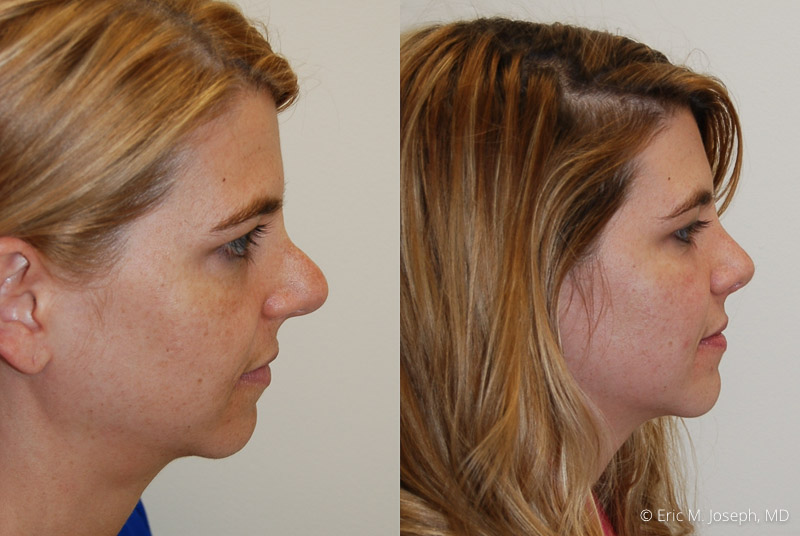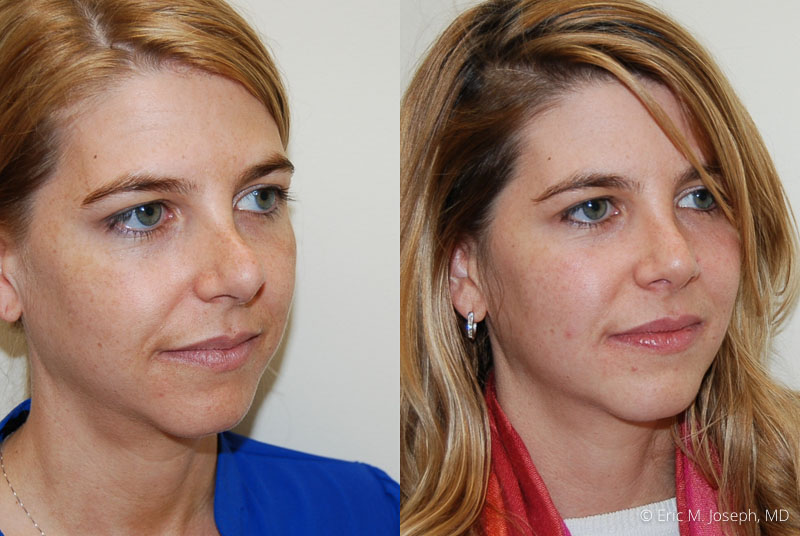Revision Rhinoplasty
A Revision Rhinoplasty may become necessary if you are dissatisfied with the appearance or function of your nose after undergoing Primary Rhinoplasty surgery. You may require a revision rhinoplasty is your nose is too long or wide, if you have a nasal hump, a droopy nasal tip, a hanging columella, or significant nasal asymmetry. Surgery may also be necessary to improve your nasal breathing. Your revision rhinoplasty surgery will be significantly more difficult than your primary rhinoplasty surgery, so the expertise of your surgeon is critical for achieving an attractive and natural looking result. During your revision rhinoplasty surgery, scar tissue may be encountered, that obscures normal tissue planes, and will require meticulous surgical dissection. Additionally, there is usually a need to harvest nasal-septal cartilage to support the nose tip and reconstruction- there may be a paucity of usable nasal cartilage after your previous Rhinoplasty surgery. Sometimes ear cartilage may be harvested and used for successful nasal rejuvenation.
Well performed revision rhinoplasty may dramatically improve your self-confidence, improve your breathing, and help you to look and feel your best by providing a more attractive and less distracting nasal appearance.
If you're unhappy with the appearance or function of your nose after previous nasal surgery, Dr Joseph is a Rhinoplasty specialist who will provide a thorough evaluation of your condition and help you move forward. When consulting with a rhinoplasty specialist for revision, it may be helpful to bring previous operative reports and preoperative photos.
Dr. Joseph's practice philosophy is to reserve revision rhinoplasty surgery as a last resort, since many people may achieve permanent improvement with Non-Surgical Rhinoplasty treatments. Depending on your condition, you may be a candidate for Silikon-1000®, an off-label filler for permanent results.
If you require a Revision Rhinoplasty Surgery, Dr. Joseph is a dual board certified ENT and facial plastic surgeon, who is an expert at performing revision rhinoplasty surgery, and who has an unsurpassed number of positive reviews from his patients. During your consultation, you will receive expert advice about your nose, and what might be best for you.
FAQ
How much does a revision rhinoplasty cost?
The cost of revision rhinoplasty varies depending on the difficulty of the case. Some people require ear cartilage to rebuild a nose if too much cartilage was removed during the first rhinoplasty. In our practice, revision rhinoplasty fees are $15,400 and up, depending on your situation. To see photos of revision rhinoplasties performed in our New Jersey facility, please visit our Revision Rhinoplasty Gallery. If you have any questions about revision rhinoplasty, please Contact Us.
How long after primary rhinoplasty can I have a revision rhinoplasty?
Because primary rhinoplasty takes about 1 year to fully heal, we may recommend waiting twelve months before another nasal surgery. This will give your nose time to heal and time for you to see your final result before making a decision. We may offer revision rhinoplasty as early and six months postoperative when people have minimal or no remaining swelling from their first surgery. An examination is necessary to determine what timing might be best for you. Many people with minor irregularities from prior rhinoplasty surgery may benefit from micro-droplet Silikon 1000, permanent nonsurgical rhinoplasty treatments. This may be the most predictable, safest, and cost effective option for people who have small irregularities, asymmetries or indentations from previous surgery. To view our results after permanent nonsurgical Nose Job treatments, please visit our Non-Surgical Rhinoplasty Gallery.
Do revision rhinoplasties take longer to heal?
It depends on the amount of work done but the answer is generally, yes. The recovery trajectory is similar to that of a primary rhinoplasty and our patients typically see an improved appearance when their dressings are removed a week after surgery. However, some patients may see residual swelling throughout the second year of recovery. Because the recovery process is long, it is important to maintain open communication with your surgeon. We schedule at least five postoperative visits the first year after your revision, and additional visits are encouraged if concerns come up.


